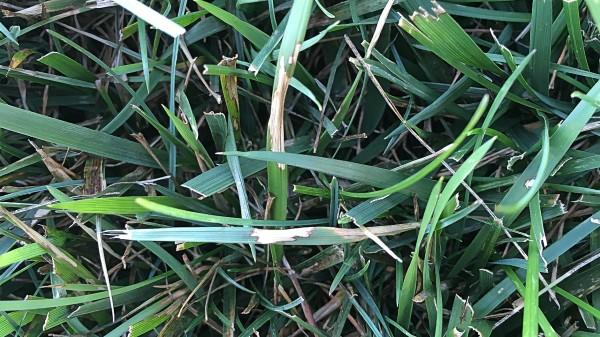Brown patch is a common summertime disease of cool-season turfgrasses in Maryland. It affects all turfgrasses, especially tall fescue and perennial rye. The disease is caused by several fungal species of Rhizoctonia. Rainy summers are worse, but even drier summers have brown patch disease pressure from moisture that develops from evening dews. Although tall fescue is the recommended turf variety for Maryland lawns most cultivars are still very susceptible to this problem disease.
Conditions that contribute to disease pressure
- Prevalent June-September, when daytime temperatures are 85º or above, nighttime temperatures are above 65º, and relative humidity is high.
- Applications of water-soluble nitrogen fertilizer, especially urea, nitrate, or ammonium in late spring-summer increase the chances of a lawn becoming infected with the disease.
Symptoms of brown patch
- Circular yellow-brown patches of thinned turf. On individual blades, elongated lesions bordered above and below by tan or chocolate-brown bands.
- Distinct patches of BP are not always evident in home lawns, but diseased grass blades are scattered throughout the lawn causing thinning and browning of turf. (photo below)



Reducing the severity
- Follow the University of Maryland Extension Lawn Fertilizer Schedule (chart).
- Avoid excess nitrogen applications (if you use weed and feed products in the spring this contributes to your total nitrogen applications for the year).
- Tall fescue lawns do not need to be watered and can be allowed to go dormant. If you have an irrigation system, set it to go off in the early morning around 6-8 am so the grass blades can dry off before evening.
- Do not plant perennial rye (check the tag on the grass seed you purchase to see what it contains) because of susceptibility to brown patch and other serious diseases. If purchasing a blend of grass species select one that contains no more than 5-10% perennial ryegrass.
- Inspect your mower blades since dull blades will leave ragged blade tips that will turn white. Dull blades will actually give the brown patch fungus a wounded area to infect the grass blade. The rule of thumb is to sharpen blades after about 10 hours of service.
Management
- This disease does not kill the crown of the turf. Most tall fescues lawns will recover with proper fall fertilization and the return of rainfall.
- During severe summers overseeding in September will help to thicken up thin areas. Choosing tall fescue cultivars with more resistance to brown patch, refer to publication (PDF) TT 77 Recommended Turfgrass Cultivars for Certified Sod and Professional Seed Mixtures, will also help reduce the overall disease severity next year.
- Fungicides available to homeowners aren’t that effective against BP and need to be applied preventively. They will not cure the disease once it has progressed. Professional lawn care companies have more effective fungicide options, but they require spraying before the disease starts and then several additional applications through the summer months.
Additional resources
(PDF) TT 77 Recommended Turfgrass Cultivars for Certified Sod and Professional Seed Mixtures
Authors: David Clement, Ph.D. HGIC Extension Specialist, Plant Pathology; Joseph Roberts, Ph.D., Assistant Professor of Turfgrass Pathology UMD; Debra Ricigliano, HGIC, Extension Program Assistant.
Still have a question? Contact us at Ask Extension.
